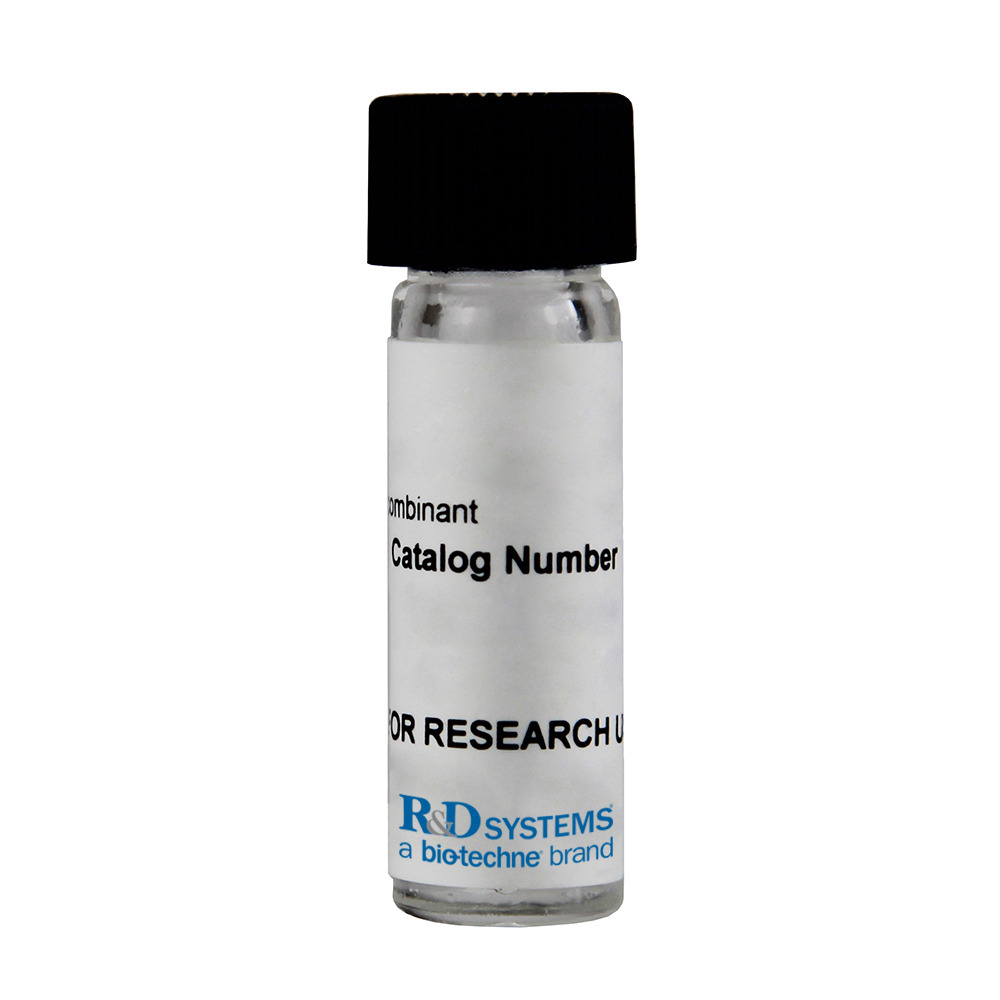Recombinant Mouse IL-12 R beta 2 Fc Chimera Protein, CF
R&D Systems, part of Bio-Techne | Catalog # 7406-MR

Key Product Details
- R&D Systems NS0-derived Recombinant Mouse IL-12 R beta 2 Fc Chimera Protein (7406-MR)
- Quality control testing to verify active proteins with lot specific assays by in-house scientists
- All R&D Systems proteins are covered with a 100% guarantee
Source
Accession #
Structure / Form
Conjugate
Applications
Product Specifications
Source
| Mouse IL-12 R beta2 (Met1-Asn637) Accession # P97378 |
IEGRMDP | Mouse IgG2A (Glu98-Lys330) |
| N-terminus | C-terminus |
Purity
Endotoxin Level
N-terminal Sequence Analysis
Predicted Molecular Mass
SDS-PAGE
Activity
When Recombinant Mouse (rm) IL‑12 R beta2 Fc Chimera is immobilized at 0.5 μg/mL (100 μL/well), the concentration of rmIL-12 that produces 50% of the optimal binding response is found to be approximately 4 ‑ 20 ng/mL.
Formulation, Preparation and Storage
7406-MR
| Formulation | Lyophilized from a 0.2 μm filtered solution in PBS. |
| Reconstitution |
Reconstitute at 100 μg/mL in PBS.
|
| Shipping | The product is shipped at ambient temperature. Upon receipt, store it immediately at the temperature recommended below. |
| Stability & Storage | Use a manual defrost freezer and avoid repeated freeze-thaw cycles.
|
Background: IL-12 R beta 2
The high‑affinity IL‑12 receptor complex includes the 100 kDa IL‑12 receptor beta1 (IL‑12 R beta1) and the 130 kDa IL‑12 Receptor beta2 (IL‑12 R beta2) subunits, both of which are type I transmembrane proteins that belong to the cytokine receptor superfamily (1, 2). The complex's ligand, IL‑12, is a disulfide‑linked heterodimer composed of 35 kDa (IL‑12 alpha p35) and 40 kDa (IL‑12 beta p40) subunits. IL‑12 R beta2 binds IL‑12 alpha and signals through Jak2, while IL‑12 R beta1 binds IL‑12 beta and signals through Tyk2 (3). IL‑12 R beta1 is also a subunit of the IL‑23 receptor complex (3). The 874 amino acid (aa) mouse IL‑12 R beta2 precursor includes a 23 aa signal peptide, a 614 aa extracellular domain (ECD), a 21 aa transmembrane segment and a 216 aa cytoplasmic region. The ECD possesses one C2‑type Ig‑like domain, five fibronectin type III (Fn III) repeats, 14 potential N‑glycosylation sites, and a WSXWS motif, while the cytoplasmic region contains a Box 1 motif and three tyrosine phosphorylation sites that presumably mediate intracellular signaling (3). The mouse IL‑12 R beta2 ECD shares 91% aa sequence identity with rat IL‑12 R beta2, and 68% with human, porcine and bovine IL‑12 R beta2. Human and mouse IL‑12 R beta2 do not bind cross‑species IL‑12 (2). A 734 aa mouse isoform that lacks aa 363‑503 within the Fn III domains is reported (4). Unlike IL‑12 R beta1, which is constitutively expressed on T cells, NK cells and B cells, IL‑12 R beta2 expression is more restricted (2). On naïve T cells, IL‑12 R beta2 is expressed following STAT1 activation by IFN‑ gamma, IL‑27 and/or T cell receptor ligation. This up‑regulation allows IL‑12 to promote Th1, but not Th2, differentiation (5‑7). Among B cells, surface expression is limited to naïve germinal center and memory B cells, and myeloma cells (2). Deletion of IL‑12 R beta2 causes systemic over-expression of IL‑6, accelerated maturation of thymocytes, deficient regulatory T cell maturation and function, and reduced splenic T cell apoptosis (2, 8-10). These mice are susceptible to autoimmune diseases such as experimental autoimmune encephalitis and spontaneous B cell malignancies (2, 8-10). In humans, polymorphism of the IL‑12 R beta2 gene is associated with systemic sclerosis (11).
References
- Presky, D.H. et al. (1996) Proc. Natl. Acad. Sci. USA 93:14002.
- Pistoia, V. et al. (2009) J. Clin. Oncol. 27:4809.
- Zou, J. et al. (1997) J. Biol. Chem. 272:6073.
- GenBank protein Accession # P97378.
- Rogge, L. et al. (1997) J. Exp. Med. 185:825.
- Becskei, A. and M.J. Grusby (2007) FEBS Lett. 581:5199.
- Szabo, S.J. et al. (1997) J. Exp. Med. 185:817.
- Zhao, Z. et al. (2008) J. Immunol. 181:3870.
- Gran, B. et al. (2010) Exp. Mol. Pathol. 89:126.
- Airoldi, I. et al. (2005) Blood 106:3846.
- Bossini-Castillo, L. et al. (2011) Hum. Mol. Genet. Nov. 29 [Epub ahead of print].
Long Name
Alternate Names
Gene Symbol
UniProt
Additional IL-12 R beta 2 Products
Product Documents for Recombinant Mouse IL-12 R beta 2 Fc Chimera Protein, CF
Product Specific Notices for Recombinant Mouse IL-12 R beta 2 Fc Chimera Protein, CF
For research use only
